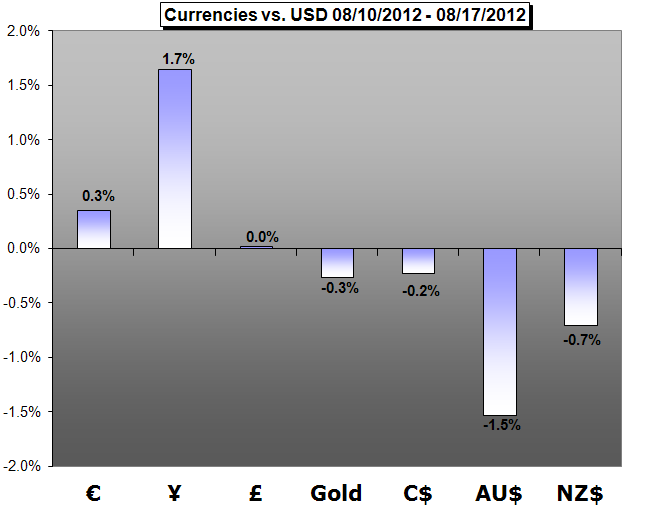Hi Everyone,
It’s Thursday which means our research team has published its weekly update of the Speculative Sentiment Index (SSI) on DailyFX.com. Below is an excerpt of from Quantitative Strategist David Rodriguez’s analysis of the latest readings from the index which point to further drops in the Euro:

Forex trading crowds have aggressively sold into overnight US Dollar (ticker: USDOLLAR) strength against the Euro and other major currencies, and the shift in sentiment suggests the EURUSD may have topped at $1.2440. Timing major currency turnarounds is always especially difficult, but a recent shift towards retail crowd EURUSD buying gives us contrarian signal that the Euro may trade towards fresh lows…
Read the full article at DailyFX.com
Hi Everyone,
Today ends a relatively quiet week in the markets, and many analysts have been using one word to characterize the current low volatility environment: complacency. In the article I want to share with you today, Jamie Saettele, Senior Technical Strategist at DailyFX.com discusses the implications on the US dollar:
You may have heard ‘complacency’ thrown around recently with respect to the current low volatility environment. The next 4 charts highlight this phenomenon. Capital markets underwent a major shift in volatility in 2007 and 2008. Simply, market volatility (uncertainty) increased and registered extreme levels in October 2008. Volatility has reverted to 2007-2008 levels. Is this another shift? Are we in for an extended period of low volatility or does this decline in volatility serve to correct a ‘bull market in volatility (uncertainty)’ before the next wave of high volatility? Viewed in the context of price pattern and other technical considerations such as momentum and sentiment, markets are on the cusp on an explosion in volatility. The implications are USD bullish and ‘risk’ bearish but trades must be structured with risk as the primary consideration. Conviction in an idea might be high but what could happen doesn’t mean it will happen.
How to Read These Charts:
-Black lines are plots of weekly close for the specific currency pair
-Green lines are 1 week volatility
-Blue lines are 1 month volatility
-Dark Red lines are 3 month volatility
-Red lines are 1 year volatility
-Red dots indicate that that week’s volatility was equal to or lower than this week’s volatility AND that this week’s volatility was the lowest so far this year
EURUSD

Read the full article at DailyFX.com
Hi Everyone,
Today the Dow and S&P finally snapped at 6-day winning streak albeit slightly, as volumes and volatility continue to remain low in global markets. As we have discussed in the past, gains in the equity markets have a high degree of correlation with other “risk on” trades in the currency markets such as the buying the Euro and Australian dollar. In the article I want to share with you today, John Kicklighter, Senior Currency Strategist at DailyFX.com looks at a few other important correlations between stocks and currencies in regards to volatility and what that can mean for currency trades going forward particularly with AUD:
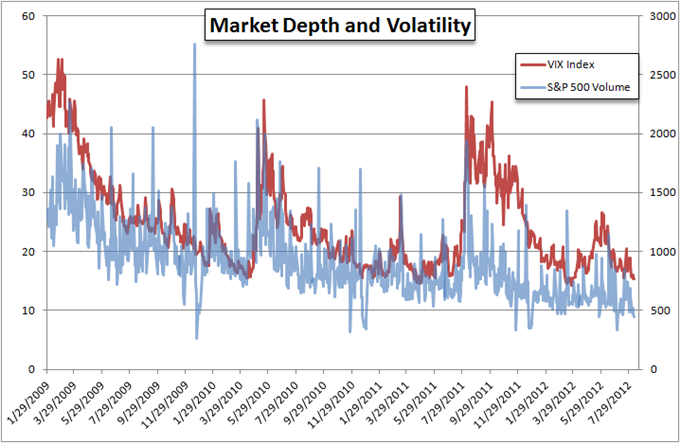
Here we have both the VIX Volatility Index and the volume reading for the S&P 500 Index. Whether it is a rebound in volatility that stirs volume or vice versa, the correlation is clear. What makes the presence circumstances more unique than what we see in this limited look-back period is that this is the lowest non-holiday volume reading since before the Great Recession and financial crisis. With the knowledge that activity levels are at extremes and more likely to revert with each day that passes; it is worth establishing the likely direction that results from that rebound in activity…
[B]Read the full article at DailyFX.com[/B]
Hi Everyone,
After covering the Australian dollar extensively this past week, I thought it would be good to share some news with you about the Japanese yen. Since testing the 79.000 level, the USD/JPY has fallen off. Jamie Saettele, Senior Technical Strategist at DailyFX.com, believes this could present an opportunity to go short. Here is an excerpt from his latest article:
USDJPY – Daily Bars

The USDJPY is in play today. After trading to its highest level since 7/18, the pair reversed sharply following the US CPI print. The pop above 7900 comes following the lowest 5 day range since mid-January (and lowest 20 day range since late December). Similar 5 day ranges were registered in December and October. Each time, the initial move was wrong and completely retraced. This is a function of the false breaks that accompany markets undergoing a shift in volatility expectations. Combined with former support turned resistance above 7900 and the 3 wave (corrective) advances from 7556 (record low) and 7765, the USDJPY is vulnerable…
[B]Read the full article at DailyFX.com[/B]
Hi Everyone,
It’s Thursday which means DailyFX.com has released its latest readings from the Speculative Sentiment Index (SSI). Quantitative Strategist David Rodriguez provides his analysis on what this means for the Euro:
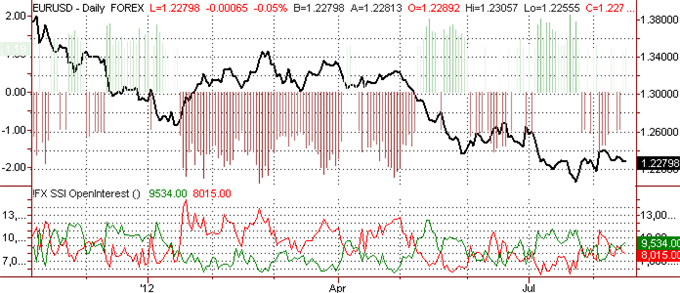
Forex trading crowds have bought into recent Euro weakness against US Dollar (ticker: USDOLLAR), and a contrarian view of crowd sentiment points to further EURUSD declines. Last week we saw signs that the Euro may have set an important short-term top at $1.2440, and indeed a series of lower highs gives conviction in calls for a short-term reversal…
Read the full analysis at DailyFX.com
The SSI is reported Every Thursday at DailyFX.com.
Jason
Hi Everyone,
We’ve come to the end of a relatively quiet week in the global markets. Volatility readings hit record lows, and US stocks continued to inch up towards the previous highs set back in May. I wanted to end by sharing some analysis on the British Pound for the coming week, since there is some key data coming out of the UK culminating with the GDP on Friday at 08:30 GMT. Below is an excerpt from a preview by Christopher Vecchio, Currency Analyst at DailyFX.com:

Fundamental Forecast for British Pound: Bearish
Although the revisions are expected to show that the British economy isn’t contracting as sharply as previously thought, the Bank of England still cut the economy’s forecasts this past week, with Governor King saying that growth would remain “subdued” in the near-term. This is despite the “erratic factors” that influenced weaker growth in the second quarter, as the Bank of England noted. But we must consider, as always, the bigger picture. Inflationary pressures have fallen in the United Kingdom, with the year-over-year Consumer Price Index holding below +3.0% for three consecutive months for the first time since October through December 2009. In light of these facts, alongside the continued streak of depressed growth in the United Kingdom, we believe that British Pound’s fundamental bull run may be stymied in the coming days and weeks, as speculation and chatter about more easing from the Bank of England will arise again…
Read the full article at DailyFX.com
Hi Everyone,
Those of you familiar with the Speculative Sentiment Index (SSI) know that it’s traditionally used as a contrarian indicator. That means when SSI indicates that the majority of traders are long a given currency pair, it’s usually taken as a sign that prices could fall going forward. That’s because those long positions have to be sold eventually and if the majority of traders are already long, it’s unlikely there is as much demand left for the price to get bid up much further. That’s the traditional thinking anyway, and while it has been useful for many of the major currencies, it has not been of much use with the Japanese yen.
Since before the start of this year, the SSI reading for USD/JPY has remained positive whether the price of USD/JPY has risen or fallen. The article I want to share with you today is by David Rodriguez, Quantitative Strategist at DailyFX.com. In this piece, he explains how SSI can still be used to get meaningful signals for USD/JPY, and what the recent changes in sentiment readings could mean for the yen going forward.
Retail Forex Trading Crowd Sentiment Pulls Back from Extremes
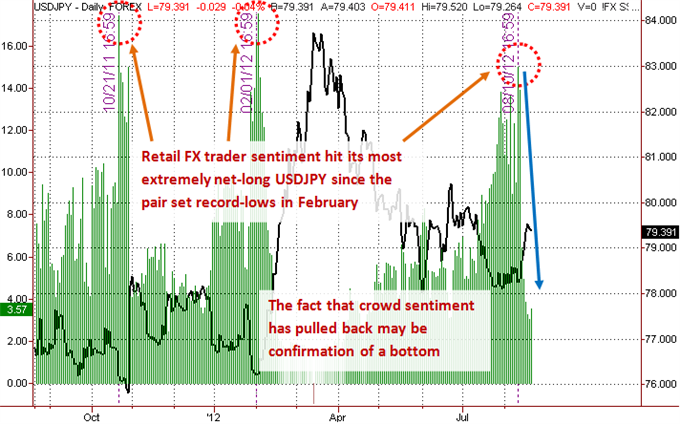
Retail crowd sentiment hit its most bullish USDJPY since the pair traded to record-lows in February, and such one-sided positioning has often coincided with lasting bottoms. According to FXCM Execution Desk data, there were as many as 15 retail traders long the US Dollar against the Japanese Yen for every one that was short. As of time of writing, that ratio has fallen to 3.6:1—its least net-long since the USDJPY set a noteworthy top in June. The sharp turnaround in retail sentiment warns of a lasting bottom, and indeed professional options traders are positioned for similar moves in the USDJPY…
[B]Read the full article at DailyFX.com[/B]
Hi Everyone,
What does more easing mean for the US dollar? Today, I wanted to share with you another edition of Scalping with Michael Boutros. In this video, our DailyFX Currency Strategist offers current setups on the majors in the aftermath of the FOMC minutes.

Jason
Hi Everyone,
In today’s video Ilya Spivak, Currency Strategist at DailyFX.com gives us a preview of what to expect this week in global markets including forex, commodities and equities.

— Created by Ilya Spivak, Currency Strategist for Dailyfx.com
Hi Everyone,
The dollar remains under pressure ahead of the annual Federal Reserve symposium where central bankers from around the world will meet in Jackson Hole, Wyoming this week. In today’s edition of his weekly scalping webinar on DailyFX.com, Currency Strategist Michael Boutros offers current setups on the majors.

Hi Everyone,
Thursday morning, we have the German Unemployment Report. The markets will be taking note, because a weak number could lead the European Central Bank to take further stimulus action. For traders interested in trading the Euro based on this news, here’s an excerpt from an article by David Song, Currency Analyst at DailyFX.com:
Greater demand from home and abroad paired with easing input prices may encourage businesses to increase hiring, and a downtick in unemployment may spark a bullish reaction in the EURUSD as it instills an improved outlook for growth. However, as business sentiment wanes, firms may keep a lid on their labor force, and a marked rise in unemployment may trigger a selloff in the exchange rate as it fuels speculation for additional monetary support.
Potential Price Targets For The Release
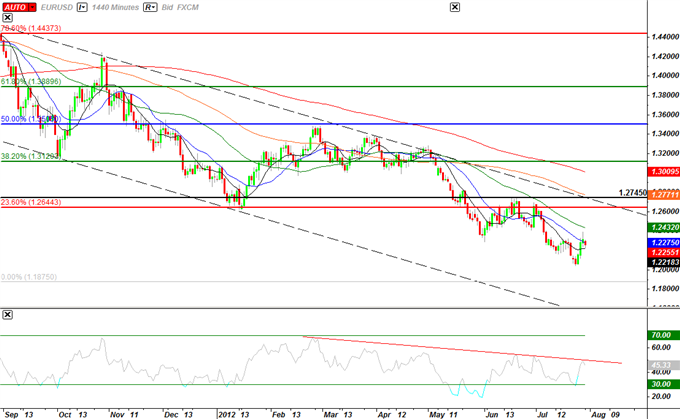
Indeed, the EURUSD stands at a critical juncture as it threatens the downward trend carried over from 2011, but the lack of momentum to push above the 100-Day SMA (1.2592) may ultimately produce a lower top in the exchange rate as the fundamental outlook for the euro-area deteriorates. In turn, we will maintain our bearish forecast for the EURUSD, but the pair may hold a narrow range ahead of the Jackson Hole Economic Symposium as the central bank conference takes center stage.
How To Trade This Event Risk
Expectations for a fifth consecutive rise in unemployment, but a positive development…
[B]Read the full article at DailyFX.com[/B]
Hi Everyone,
In his weekly update of the Speculative Sentiment Index (SSI) on DailyFX.com, Quantitative Strategist David Rodriguez explains why now might be the time to go against the crowd by “buying into EUR/USD strength”. Below is an excerpt from his report today:
[I]Retail FX crowds remain long the US Dollar (ticker: USDOLLAR) against the Euro, and going against the crowd means buying into EURUSD strength. Yet exceedingly quiet conditions ahead of a highly-anticipated Fed address in Jackson Hole warns against taking aggressive trades.

Crowds continue buying the US Dollar against the Euro, British Pound, Japanese Yen, Swiss Franc, and Canadian Dollar—normally a crystal-clear signal for us to favor further USD weakness. Yet it’s critical to note…[/I]
[B]Read the full report at DailyFX.com[/B]
Hi Everyone,
This Friday, DailyFX.com Currency Analyst Christopher Vecchio will provide live coverage of Ben Bernanke’s address an the Fed’s annual symposium in Jackson Hole, Wyoming where central bankers from around the world have been meeting this week.

Click on the image above at 10am New York time (14:00 GMT) to join in on the live coverage and get your questions answered in real-time in DailyFX’s Live Trading Room.
Jason
Hi Everyone,
With US markets closed today because of the Labor Day holiday, I thought I’d start the week with an outlook on the Euro for September and beyond. Below is an excerpt of an article by Christopher Vecchio, Currency Analyst at DailyFX.com:
The Euro’s exchange rate versus the US Dollar continues to languish given the real danger it will cease to exist as we know it, and the potential fallout for broader financial markets of a Euro breakdown could be significant. Viewed as such, the EURUSD offers important insight into recent developments in the Euro-zone and represents an important bellwether for not only European equity and bond markets, but broader global assets.

[I]After falling to fresh multi-year lows through the first half of the year, however, the EURUSD remains surprisingly resilient. A recovery in Italian and Spanish bond prices showed investor confidence improved as European Central Bank President Mario Draghi pledged to do “whatever it takes” to keep the Euro-zone together. The decreased funding costs for these countries comes against a worrisome backdrop of Spain on the verge of a sovereign bailout after receiving aid north of €100 billion for its banks in mid-June. As the Euro-zone’s fourth-largest economy, Spain’s funding needs would be substantial.
Add the increased possibility that Greece could be pushed out of the Euro-zone within the coming weeks, and it is easy to understand the wild ranges in the Euro/US Dollar over the past few weeks, trading as low as 1.2041 in July before rebounding to near 1.2600 this past week. Needless to say, the past few months have been quite the rollercoaster.
We have detailed the two most important story lines to follow to understand the ebbs and flows of the crisis and the future of the Euro, at least through the rest of 2012…[/I]
[B]Read the full article at DailyFX.com[/B]
Hi Everyone,
Today, I wanted to share an article by DailyFX Quantitative Strategist David Rodriguez that draws correlations between the Aussie dollar and the S&P 500 Volatility Index to signal a trading opportunity. Below is an excerpt:

[I]A group of equity market strategists at Goldman Sachs recently issued a report recommending that readers go long Puts on the S&P 500 that expire on September 14—options that give the buyer the option to sell the S&P at a predetermined price. Why? The S&P 500 Volatility Index looks especially low given critical European and US economic event risk through the end of this week warns and a pivotal German vote on September 12.
The recommended trade would do well if the S&P VIX surges and/or the S&P 500 falls before September 14.
[B]How do we trade such big event risk?[/B]
Given the strong correlation between stocks, the VIX, and the AUDUSD, we believe that an Australian Dollar-short position would likewise do well in such conditions.
Is now the time to buy Australian Dollar weakness?[/I]
[B]Read the full article at DailyFX.com[/B]
Hi Everyone,
It’s Thursday, which means it’s time to take a look at the weekly update of the Speculative Sentiment Index (SSI) from DailyFX.com. And today’s readings carry special importance. The ECB went against expectations earlier today in holding rates at 0.75% when the consensus among economists was for a rate cut to 0.50%. Traders reacted by selling the Euro across the board, and as the latest SSI readings show, retail traders remain short the single currency. In his analysis of SSI today, Quantitative Strategist David Rodriguez explains why the crowds may have it right this time.
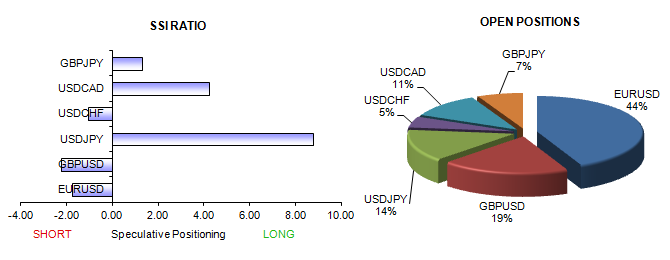
FXCM Execution Desk data shows that retail traders remain heavily long the US Dollar (ticker: USDOLLAR) against the Euro, and a disappointment in the recent ECB rate decision suggests the crowd stands to gain on EURUSD declines. We most often go against crowd sentiment, and the fact that crowds are heavily short EURUSD would normally lead us to go in the opposite direction and call for gains. Yet our Speculative Sentiment Index works best as…
Read the full article at DailyFX.com
Hi Everyone,
Today’s weak jobs number led to further selling of the US dollar heading into next week’s FOMC meeting. According to DailyFX Currency Analyst David Song, "The central bank may sound increasingly dovish amid the persistent weakness in the labor market. In turn, growing speculation for another round of quantitative easing may produce additional declines in the dollar…
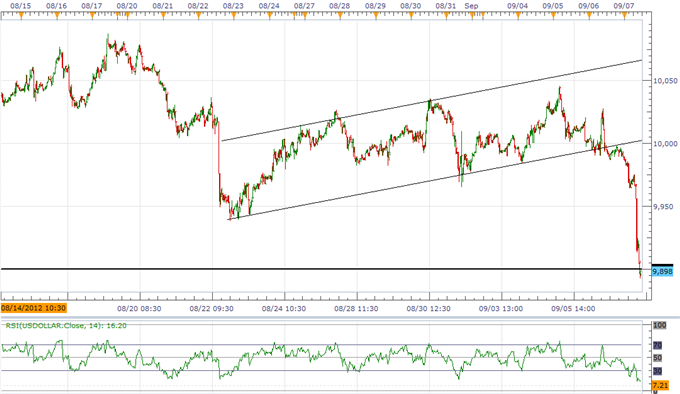
“Indeed, the FOMC interest rate decision highlights the biggest event risk for the following week, and we may see the dollar trade heavy going into the policy meeting as a growing number of central bank officials lean towards more easing. There’s speculation that the Fed will implement an ‘open-ended’ QE program next week as Chairman Ben Bernanke looks for a stronger recovery, but the meeting may disappoint should we see the committee continue to rely on its transmission mechanisms. At the same time, we will be closely watching the updated forecast for growth and inflation as the central bank takes note of the slowing recovery, and Chairman Bernanke may sound rather downbeat at the press conference following the meeting amid the ongoing slack in the real economy…”
[B]Read the full article at DailyFX.com[/B]
Hi Everyone,
The main event this week is the Fed meeting on Thursday. There are three components to the event: the policy decision (16:30 GMT), the release of the fundamental forecasts (18:00 GMT) and Chairman Bernanke’s press conference (18:15 GMT). After the US dollar hit four-month lows following another lackluster jobs number last Friday, traders will be looking to the Fed for indications of future direction in the markets. Below is an article by DailyFX’s Senior Currency Strategist John Kicklighter where he breaks down what to watch for this week.
[I]The dollar was dealt a hefty blow this past week. The Dow Jones FXCM Dollar Index (ticker = USDollar) dove into four-month lows Friday with its biggest single-day decline in 10 weeks. From a chart of the USDollar or EURUSD, it seems as if the dollar has had the floor ripped out from underneath it. However, selling momentum is not guaranteed. In fact, it will be more difficult to sustain than many may suspect. Whether or not EURUSD overtakes 1.3000 and AUDUSD surmounts 1.0600 is a matter for the Federal Reserve to decide.
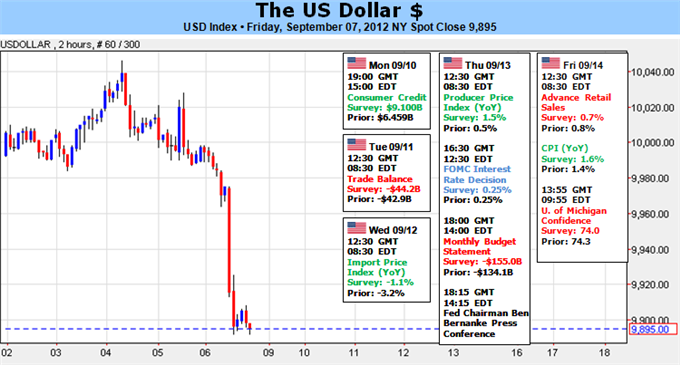
To gain a sense of the dollar’s orientation over the coming week, we need to assess what fundamental themes are in control and what will provoke their development moving forward. Without doubt, the greenback’s greatest adversary moving forward is the Fed rate decision scheduled Thursday (16:30 GMT). Yet, why is the policy meeting so influential to the currency? Because of its direct impact on the currency’s value (via money supply and yields) and the sway over risk appetite trends (the greenback is the market’s preferred safe haven currency).
Market-wide investor sentiment (risk trends) carries the greatest…[/I]
[B]Read the full article at DailyFX.com[/B]
Hi Everyone,
As expected the German Constitutional Court ratified the European Stability Mechanism (ESM) which means Germany will contribute up to €190 billion for buying Itallian and Spanish bonds to help keep borrowing costs low in those countries. Since this was a key step in putting this bailout fund in place, the markets took it as a positive sign and the Euro surged to fresh highs up 100 pips from yesterday and is trading around 1.2900 against the US dollar. Here’s a video on DailyFX.com today about Making the Most Out of EUROphoria:
[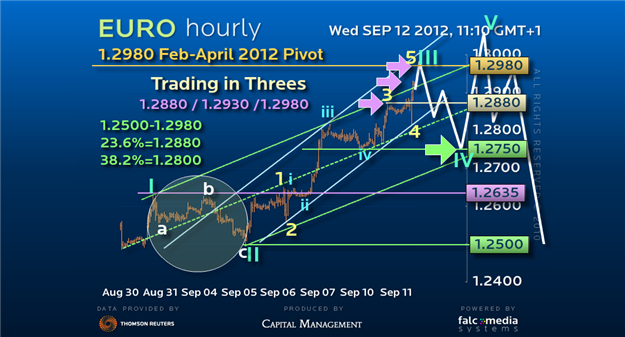
Click Image to Watch Video on DailyFX.com](http://bit.ly/QK2bpe)






